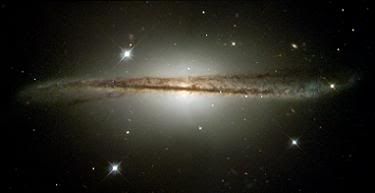Post by glactus on Jul 10, 2011 1:43:13 GMT

Galactic evolution
After the Big Bang, the universe, for a time, was remarkably homogeneous, as can be observed in the Cosmic Microwave Background. There was little-to-no structure in the universe, and thus no galaxies. Therefore we must ask how the smoothly distributed universe became the clumpy universe we see today.

The beautiful Sombrero galaxy in Virgo
The most accepted theory of how these structures came to be is that all the structure we observe today was formed as a consequence of the growth of the primordial fluctuations, which are small changes in the density of the universe in a confined region. As the universe cooled clumps of dark matter began to condense, and within them gas began to condense. The primordial fluctuations gravitationally attracted gas and dark matter to the denser areas, and thus the seeds that would later become galaxies were formed.

The galaxy ESO 510- G13 in Hydra
At this point the universe was almost exclusively composed of hydrogen, helium, and dark matter. Soon after the first proto-galaxies formed the hydrogen and helium gas within them began to condense and make the first stars. Thus the first galaxies were then formed.
In 2007 the Keck telescope, a team from California Institute of Technology found six star forming galaxies about 13.2 billion light years away and therefore created when the universe was only 500 million years old. The discovery of a galaxy more than 13 billion years old, was reported in January 2011 which existed only 480 million years after the Big Bang.
The universe was very violent in its early epochs, and galaxies grew quickly, evolving by accretion of smaller mass galaxies. The result of this process is left imprinted on the distribution of galaxies in the nearby universe.
Looking at the Sombrero galaxy
Credits: These are NASA/Hubble images
Text by Wikipedia
Special credit: The Californian institute of technology
Telescope in avatar: Meade 16" LX 200
Astronomer in avatar: Glactus


